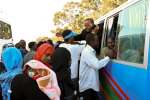A safe Romanian pit stop on the road to resettlement
News Stories, 13 January 2015
TIMISOARA, Romania, January 13 (UNHCR) – Ahmed, a 24-year-old Somali, sat in a bus and fidgeted anxiously as it took him and a group of fellow refugees from Timisoara's Emergency Transit Centre (ETC) on a trip outside the city in western Romania.
The journey was a simple excursion – part of the ETC's programme to prepare particularly vulnerable refugees for resettlement in a new country. But for Ahmed, who had spent years either in flight or in camps, it was a journey into the free world – one he has had little experience with.
"From the moment we left the city," he said, "I expected to see one checkpoint after another. In Yemen, if you are a refugee at a checkpoint, you are in trouble," added the young man, who grew up in Yemen's Kharaz refugee camp after fleeing from Somalia with his parents aged just six years old.
There was no trouble on that day for Ahmed and the others. The group toured the Romanian countryside, and then returned to the transit centre, which was set up in 2008 by the Romanian government, UNHCR and the International Organization for Migration to provide a temporary haven for refugees in urgent need of evacuation from their first asylum countries. They can stay for up to six months of language and cultural orientation before being resettled.
But Ahmed's trepidation underscores how difficult it is for many to make the transition from refugee. The small number of ETCs around the world can mark an end to years of traumatic and crowded camp life.
In Yemen's Kharaz camp, Ahmed and his family lived in a simple shelter. Every day was a struggle to find food, and life outside the camp posed dangers. Ahmed joined the staff of a humanitarian agency once he was old enough to work. In time, being a refugee was all Ahmed understood.
"I grew up listening to refugee stories," he said. "I met refugees who had lost someone dear to them or had been thrown in the ocean [during the dangerous high seas boat crossing from Somalia] but survived, their skin burned by salty water and [their minds] traumatized for life," he recalled.
For Ahmed and his family, the reality of spending their lives in a camp was unexpected. Like many displaced people, they had considered their predicament temporary, and thought that a chance to return home lay around the corner.
But 18 years after fleeing Somalia, Ahmed's family was still languishing in Kharaz, and in limbo. "Life in the camp was not stable," he said. "We could never settle. You never know what will happen tomorrow as your life is never fully in your hands."
Ahmed's life as a refugee began so early he knew nothing else. His first memories were of fleeing. "I can still see my father getting into the truck, and telling me to stay there and look after our belongings," he said. "Now when I look back I realize how sad and emotional that trip must have been for my parents. That truck ride changed our lives for good."
Ahmed and his parents are now facing another change, and they hope a happier one. Selected for resettlement in the west, they were brought to Timisoara to prepare for a new home in a new land.
After almost two decades of camp life, it has not been an easy transition. But they were not alone. The Emergency Transit Centre in Timisoara has room for up to 200 occupants at any one time, and some 1,500 refugees have passed through the facility since it was opened.
These people come from different countries and walks of life. The one thing that unites them is their vision of a better future; one without conflict or persecution and where they will have a chance to work, prosper and raise a family in peace.
Ahmed looked forward to two things when he leaves Timisoara – freedom and belonging. "The moment I get to my new home," he said, "I'll go out and walk the streets. I want to know my new city, feel the freedom, and the sense of citizenship."
By Gabriela Leu in Timisoara, Romania





















































